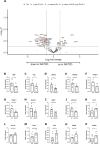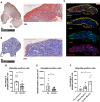Diminished expression of the ubiquitin-proteasome system in early treatment-naïve patients with rheumatoid arthritis and concomitant type 2 diabetes may be linked to IL-1 pathway hyper-activity; results from PEAC cohort
- PMID: 39342401
- PMCID: PMC11437779
- DOI: 10.1186/s13075-024-03392-9
Diminished expression of the ubiquitin-proteasome system in early treatment-naïve patients with rheumatoid arthritis and concomitant type 2 diabetes may be linked to IL-1 pathway hyper-activity; results from PEAC cohort
Abstract
Objective: Based on the recent evidence of IL-1 inhibition in patients with rheumatoid arthritis (RA) and concomitant type 2 diabetes (T2D), we evaluated the synovial tissue expression of IL-1 related genes in relationship to the ubiquitin-proteasome system and the effects of insulin on ubiquitinated proteins in fibroblast-like synoviocytes (FLSs).
Methods: The synovial expression of IL-1 pathway genes was compared in early (< 1 year) treatment-naïve RA patients with T2D (RA/T2D n = 16) and age- and sex-matched RA patients without T2D (n = 16), enrolled in the Pathobiology of Early Arthritis Cohort (PEAC). The synovial expression of ubiquitin in macrophages and synovial lining fibroblasts was also assessed by Immunohistochemistry/immunofluorescence and correlated with synovial pathotypes. Finally, FLSs from RA patients (n = 5) were isolated and treated with human insulin (200 and 500 nM) and ubiquitinated proteins were assessed by western blot.
Results: Synovial tissues of RA/T2D patients were characterised by a consistent reduced expression of ubiquitin-proteasome genes. More specifically, ubiquitin genes (UBB, UBC, and UBA52) and genes codifying proteasome subunits (PSMA2, PSMA6, PSMA7, PSMB1, PSMB3, PSMB4, PSMB6, PSMB8, PSMB9, PSMB10, PSMC1, PSMD9, PSME1, and PSME2) were significantly lower in RA/T2D patients. On the contrary, genes regulating fibroblast functions (FGF7, FGF10, FRS2, FGFR3, and SOS1), and genes linked to IL-1 pathway hyper-activity (APP, IRAK2, and OSMR) were upregulated in RA/T2D. Immunohistochemistry showed a significant reduction of the percentage of ubiquitin-positive cells in synovial tissues of RA/T2D patients. Ubiquitin-positive cells were also increased in patients with a lympho-myeloid pathotype compared to diffuse myeloid or pauci-immune-fibroid. Finally, in vitro experiments showed a reduction of ubiquitinated proteins in RA-FLSs treated with a high concentration of insulin (500 nM).
Conclusions: A different IL-1 pathway gene expression was observed in the synovial tissues of early treatment-naïve RA/T2D patients, linked to decreased expression of the ubiquitin-proteasome system. These findings may provide a mechanistic explanation of the observed clinical benefits of IL-1 inhibition in patients with RA and concomitant T2D.
Keywords: IL-1β, ubiquitin; Of Early Arthritis Cohort study (PEAC); Pathobiology; Rheumatoid arthritis; Synovial biopsy; Type 2 diabetes.
© 2024. The Author(s).
Conflict of interest statement
The authors declare no competing interests.
Figures



Similar articles
-
The tumour-associated glycoprotein podoplanin is expressed in fibroblast-like synoviocytes of the hyperplastic synovial lining layer in rheumatoid arthritis.Arthritis Res Ther. 2011 Mar 7;13(2):R40. doi: 10.1186/ar3274. Arthritis Res Ther. 2011. PMID: 21385358 Free PMC article.
-
Evaluation of TAK-242 (Resatorvid) Effects on Inflammatory Status of Fibroblast-like Synoviocytes in Rheumatoid Arthritis and Trauma Patients.Iran J Allergy Asthma Immunol. 2021 Aug 7;20(4):453-464. Iran J Allergy Asthma Immunol. 2021. PMID: 34418899
-
Resistin upregulates chemokine production by fibroblast-like synoviocytes from patients with rheumatoid arthritis.Arthritis Res Ther. 2017 Dec 1;19(1):263. doi: 10.1186/s13075-017-1472-0. Arthritis Res Ther. 2017. PMID: 29191223 Free PMC article.
-
Predicting best treatment in rheumatoid arthritis.Semin Arthritis Rheum. 2024 Feb;64S:152329. doi: 10.1016/j.semarthrit.2023.152329. Epub 2023 Nov 22. Semin Arthritis Rheum. 2024. PMID: 38008706 Review.
-
New Posttranslational Modification Lactylation Brings New Inspiration for the Treatment of Rheumatoid Arthritis.J Inflamm Res. 2024 Dec 30;17:11845-11860. doi: 10.2147/JIR.S497240. eCollection 2024. J Inflamm Res. 2024. PMID: 39758940 Free PMC article. Review.
Cited by
-
Synovial infiltrating immune cell heterogeneity associated with synovitis severity and systemic disease activity in rheumatoid arthritis: a cross-sectional study.Clin Rheumatol. 2025 Sep;44(9):3487-3495. doi: 10.1007/s10067-025-07565-y. Epub 2025 Jul 30. Clin Rheumatol. 2025. PMID: 40739375
-
Patients with psoriatic arthritis and comorbid metabolic syndrome show a difficult-to-treat phenotype: another mosaic tile in the definition of a still undefined subset of patients.RMD Open. 2025 Jun 22;11(2):e005717. doi: 10.1136/rmdopen-2025-005717. RMD Open. 2025. PMID: 40545272 Free PMC article.
References
-
- Nurmohamed MT, Heslinga M, Kitas GD. Cardiovascular comorbidity in rheumatic diseases. Nat Rev Rheumatol. 2015;11(12):693–704. 10.1038/nrrheum.2015.112. Epub 2015 Aug 18 PMID: 26282082. - PubMed
-
- Ruscitti P, Cipriani P, Liakouli V, Iacono D, Pantano I, Margiotta DPE, Navarini L, Destro Castaniti GM, Maruotti N, Di Scala G, Caso F, Bongiovanni S, Grembiale RD, Atzeni F, Scarpa R, Perosa F, Emmi G, Cantatore FP, Guggino G, Afeltra A, Ciccia F, Giacomelli R. Occurrence and predictive factors of high blood pressure, type 2 diabetes, and metabolic syndrome in rheumatoid arthritis: findings from a 3-year, multicentre, prospective, observational study. Clin Exp Rheumatol. 2021;39(5):995–1002 Epub 2020 Dec 4. PMID: 33337994. - PubMed
-
- Donath MY. Targeting inflammation in the treatment of type 2 diabetes: time to start. Nat Rev Drug Discov. 2014;13(6):465–76. 10.1038/nrd4275. Epub 2014 May 23 PMID: 24854413. - PubMed
-
- Giacomelli R, Ruscitti P, Alvaro S, Ciccia F, Liakouli V, Di Benedetto P, Guggino G, Berardicurti O, Carubbi F, Triolo G, Cipriani P. IL-1β at the crossroad between rheumatoid arthritis and type 2 diabetes: may we kill two birds with one stone? Expert Rev Clin Immunol. 2016;12(8):849–55. 10.1586/1744666X.2016.1168293. Epub 2016 Apr 12 PMID: 26999417. - PubMed
MeSH terms
Substances
Grants and funding
LinkOut - more resources
Full Text Sources
Medical
Research Materials
Miscellaneous

